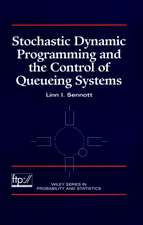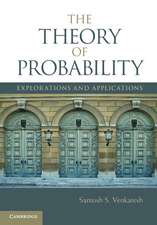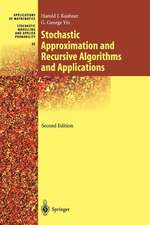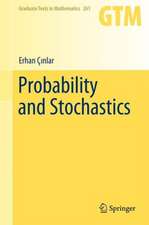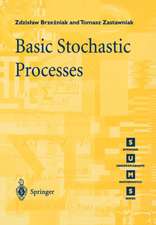Heavy-Tail Phenomena: Probabilistic and Statistical Modeling: Springer Series in Operations Research and Financial Engineering
Autor Sidney I. Resnicken Limba Engleză Paperback – 23 noi 2010
| Toate formatele și edițiile | Preț | Express |
|---|---|---|
| Paperback (1) | 501.41 lei 6-8 săpt. | |
| Springer – 23 noi 2010 | 501.41 lei 6-8 săpt. | |
| Hardback (1) | 529.48 lei 38-44 zile | |
| Springer – dec 2006 | 529.48 lei 38-44 zile |
Din seria Springer Series in Operations Research and Financial Engineering
- 13%
 Preț: 355.75 lei
Preț: 355.75 lei - 17%
 Preț: 370.05 lei
Preț: 370.05 lei - 15%
 Preț: 365.76 lei
Preț: 365.76 lei - 17%
 Preț: 363.08 lei
Preț: 363.08 lei -
 Preț: 347.47 lei
Preț: 347.47 lei -
 Preț: 497.00 lei
Preț: 497.00 lei -
 Preț: 356.91 lei
Preț: 356.91 lei - 19%
 Preț: 575.59 lei
Preț: 575.59 lei - 15%
 Preț: 638.43 lei
Preț: 638.43 lei - 18%
 Preț: 740.57 lei
Preț: 740.57 lei - 18%
 Preț: 945.30 lei
Preț: 945.30 lei - 20%
 Preț: 639.28 lei
Preț: 639.28 lei -
 Preț: 384.48 lei
Preț: 384.48 lei - 23%
 Preț: 732.07 lei
Preț: 732.07 lei -
 Preț: 407.98 lei
Preț: 407.98 lei - 18%
 Preț: 1395.63 lei
Preț: 1395.63 lei -
 Preț: 358.39 lei
Preț: 358.39 lei - 20%
 Preț: 549.58 lei
Preț: 549.58 lei - 18%
 Preț: 737.43 lei
Preț: 737.43 lei - 15%
 Preț: 660.37 lei
Preț: 660.37 lei -
 Preț: 411.67 lei
Preț: 411.67 lei -
 Preț: 391.02 lei
Preț: 391.02 lei - 18%
 Preț: 898.13 lei
Preț: 898.13 lei -
 Preț: 405.06 lei
Preț: 405.06 lei - 15%
 Preț: 637.28 lei
Preț: 637.28 lei -
 Preț: 495.84 lei
Preț: 495.84 lei - 19%
 Preț: 526.97 lei
Preț: 526.97 lei -
 Preț: 391.02 lei
Preț: 391.02 lei -
 Preț: 392.97 lei
Preț: 392.97 lei - 15%
 Preț: 538.61 lei
Preț: 538.61 lei - 15%
 Preț: 880.15 lei
Preț: 880.15 lei - 24%
 Preț: 831.85 lei
Preț: 831.85 lei - 18%
 Preț: 837.15 lei
Preț: 837.15 lei - 18%
 Preț: 801.65 lei
Preț: 801.65 lei - 19%
 Preț: 529.48 lei
Preț: 529.48 lei -
 Preț: 391.42 lei
Preț: 391.42 lei - 15%
 Preț: 592.77 lei
Preț: 592.77 lei
Preț: 501.41 lei
Nou
Puncte Express: 752
Preț estimativ în valută:
95.96€ • 99.81$ • 79.22£
95.96€ • 99.81$ • 79.22£
Carte tipărită la comandă
Livrare economică 14-28 aprilie
Preluare comenzi: 021 569.72.76
Specificații
ISBN-13: 9781441920249
ISBN-10: 1441920242
Pagini: 424
Ilustrații: XIX, 404 p.
Greutate: 0.74 kg
Ediția:2007
Editura: Springer
Colecția Springer
Seria Springer Series in Operations Research and Financial Engineering
Locul publicării:New York, NY, United States
ISBN-10: 1441920242
Pagini: 424
Ilustrații: XIX, 404 p.
Greutate: 0.74 kg
Ediția:2007
Editura: Springer
Colecția Springer
Seria Springer Series in Operations Research and Financial Engineering
Locul publicării:New York, NY, United States
Public țintă
ResearchCuprins
Crash Courses.- Crash Course I: Regular Variation.- Crash Course II: Weak Convergence; Implications for Heavy-Tail Analysis.- Statistics.- Dipping a Toe in the Statistical Water.- Probability.- The Poisson Process.- Multivariate Regular Variation and the Poisson Transform.- Weak Convergence and the Poisson Process.- Applied Probability Models and Heavy Tails.- More Statistics.- Additional Statistics Topics.- Appendices.- Notation and Conventions.- Software.
Textul de pe ultima copertă
This comprehensive text gives an interesting and useful blend of the mathematical, probabilistic and statistical tools used in heavy-tail analysis. Heavy tails are characteristic of phenomena where there is a significant probability of a single huge value impacting system behavior. Record-breaking insurance losses, financial returns, sizes of files stored on a server, transmission rates of files are all examples of heavy-tailed phenomena.
Key features:
Unique text devoted to heavy-tails.
The treatment of heavy tails is largely dimensionless.
The text gives attention to both probability modeling and statistical methods for fitting models. Most other books focus on one or the other but not both.
The book emphasizes the broad applicability of heavy-tails to the fields of finance (e.g., value-at- risk), data networks, insurance.
The presentation is clear, efficient and coherent and, balances theory and data analysis to show the applicability andlimitations of certain methods.
Several chapters examine in detail the mathematical properties of the methodologies as well as their implementation in the Splus or R statistical languages.
The exposition is driven by numerous examples and exercises.
Prerequisites for the reader include a prior course in stochastic processes and probability, some statistical background, some familiarity with time series analysis, and ability to use (or at least to learn) a statistics package such as R or Splus. This work will serve second-year graduate students and researchers in the areas of operations research, statistics, applied mathematics, electrical engineering, financial engineering, networking and economics.
Sidney Resnick is a Professor at Cornell University and has written several well-known bestsellers: A Probability Path (ISBN: 081764055X), Adventures in Stochastic Processes (ISBN: 0817635912) and Extreme Values, Regular Variation, and Point Processes (ISBN: 0387964819).
Key features:
Unique text devoted to heavy-tails.
The treatment of heavy tails is largely dimensionless.
The text gives attention to both probability modeling and statistical methods for fitting models. Most other books focus on one or the other but not both.
The book emphasizes the broad applicability of heavy-tails to the fields of finance (e.g., value-at- risk), data networks, insurance.
The presentation is clear, efficient and coherent and, balances theory and data analysis to show the applicability andlimitations of certain methods.
Several chapters examine in detail the mathematical properties of the methodologies as well as their implementation in the Splus or R statistical languages.
The exposition is driven by numerous examples and exercises.
Prerequisites for the reader include a prior course in stochastic processes and probability, some statistical background, some familiarity with time series analysis, and ability to use (or at least to learn) a statistics package such as R or Splus. This work will serve second-year graduate students and researchers in the areas of operations research, statistics, applied mathematics, electrical engineering, financial engineering, networking and economics.
Sidney Resnick is a Professor at Cornell University and has written several well-known bestsellers: A Probability Path (ISBN: 081764055X), Adventures in Stochastic Processes (ISBN: 0817635912) and Extreme Values, Regular Variation, and Point Processes (ISBN: 0387964819).
Caracteristici
Unique text devoted to heavy-tails The treatment of heavy tails is largely dimensionless The text gives attention to both probability modeling and statistical methods for fitting models. Most other books focus on one or the other but not both The book emphasizes the broad applicability of heavy-tails to the fields of finance (e.g., value-at- risk), data networks, insurance The presentation is clear, efficient and coherent and, balances theory and data analysis to show the applicability and limitations of certain methods Several chapters examine in detail the mathematical properties of the methodologies as well as their implementation in the Splus or R statistical languages The exposition is driven by numerous examples and exercises






